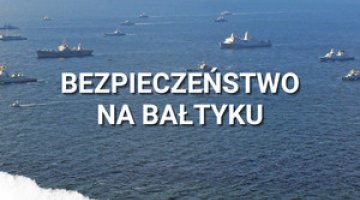The prospects for the Baltic states’ military co-operation
The Chiefs of Defence of Lithuania, Latvia and Estonia met on 8 and 9 November in Kernave, Lithuania, to discuss military co-operation projects, including their joint contribution to the NATO Response Force, the Nordic Battle Group, and enhancing co-operation with regard to exercises and training. The joint actions proposed indicate a gradual intensification and renewed integration (as occurred previously in the 1990s) of political and military activity of the Baltic states within NATO, in their relations with the Nordic states alongside trilateral military and technical co-operation of the Baltic armed forces.The impulse for developing military collaboration stemmed partly from the Russian-Georgian conflict in 2008 and cuts in the defence budgets of the Baltic states resulting from the economic crisis. The Baltic states are likely to continue their political and military co-operation as part of NATO and EU initiatives, such as their joint contribution to the NATO Response Force or the Nordic Battle Group. In turn, the possibilities of closer military and technical co-operation between the Baltic states as regards common procurement, exercises and training depend to a greater extent on such factors as the level of the defence sector’s financing or the efficient management of national armed forces.
The beginnings of co-operation between the Baltic states
Military co-operation between Lithuania, Latvia and Estonia dates back to the 1990s. At that time it was a consequence of the Nordic states’ engagement in the development of the Baltic armed forces and defence capabilities and also a result of the joint effort by the three Baltic states to join NATO. These processes led to the creation of: BALTNET, the Baltic Air Surveillance Network, which became part of the NATO Integrated Air Defence System; the Baltic mine countermeasures naval squadron, BALTRON, which is now part of the Standing NATO Mine Countermeasures Group 1; and the Baltic Defence College. Owing to the joint effort from the Baltic states, NATO’s air policing mission was extended over their territory. Following their accession to NATO, there was no single factor serving to integrate the efforts of these three countries, and consequently their co-operation became less intense and was continued only as part of the aforementioned initiatives. Despite their modest military capabilities (see Appendix), the Baltic states were not interested in further regional integration, and instead preferred to develop bilateral relations with larger partners, predominantly Western. These partners (the Nordic states, France, the United Kingdom and the USA) backed them in building their military capabilities, for example through consulting, training events, donating or selling used armament and military equipment and joint exercises. This later resulted in bilateral operational co-operation on foreign missions (in the Balkans and in Afghanistan).
The security and financial crisis: the development of military co-operation after 2008
The Russian-Georgian conflict in 2008 and the earlier crises between the Baltic states and Russia (such as cyber-attacks and the riots surrounding the relocation of the ‘Bronze Soldier’ monument) reintegrated the political and military activity of Lithuania, Latvia and Estonia inside NATO and in their relations with the Nordic states. This co-operation is aimed at improving the security of the Baltic states, which have limited military capabilities and rely on support from their allies if threatened.
Since 2008, this co-operation has included the introduction of contingency planning encompassing the Baltic states, increasing the military presence (exercises) of the USA and NATO in the region, and introducing provisions which emphasise the aspect of collective defence in NATO’s new Strategic Concept. At present, joint actions (to an increasing extent) also concern specific military initiatives which are aimed at making the Baltic states more visible in NATO and emphasising their contribution to the development of NATO’s expeditionary and defence capabilities (in the region) as well as the capabilities needed to handle ‘new’ threats. The Lithuanian-Latvian-Estonian Baltic Battalion is set to be re-established in 2016 as a part of the land component of the NATO Response Force. It will consist of approximately 800 soldiers (such a battalion was formed for the first time in 2010). The Baltic states are placing special emphasis on joint exercises and collaboration in their military and civilian support for NATO allied forces, which can move or be deployed within their territories (Host Nation Support). They have also decided (albeit partly under pressure from their allies) to raise the level of their expenditure on the Baltic Air Policing mission. It is worth mentioning, in the context of improving the visibility inside NATO, the Centres of Excellence (CoE) which are backed by the three Baltic states in this region and are aimed at handling ‘new’ threats. These are: the Cyber Defence CoE established in 2008 in Tallinn, in which Lithuania and Latvia have participated from the beginning; and the Energy Security CoE, which was opened in October this year in Vilnius with the participation of Latvia and Estonia.
The desire to strengthen the military links with the Nordic states has also made a great impact on deepening Baltic states’ military co-operation. Nordic-Baltic co-operation in security and defence is becoming increasingly attractive for Lithuania, Latvia and Estonia – this indirectly provides them with additional security guarantees owing to the greater interoperability and the building of stronger links between the armed forces of the countries in this region, including Sweden and Finland. The coordination of activities between the three Baltic states strengthens their position vis-à-vis the Nordic states in the Nordic-Baltic co-operation. For this reason, the Baltic states decided this autumn on coordinated participation in the EU’s Nordic Battle Group (NBG) – it was agreed in October this year that Lithuania and Latvia would take part in the NBG (Estonia had already participated in the NBG in 2008 and 2011). The NBG is supposed to be on duty in 2015, preparations for which have already begun. The NBG, whose participants are Sweden (the framework nation), Finland, Norway, Estonia and Ireland, is also seen as a laboratory of regional co-operation which envisages participation in foreign operations – not only within the EU but also as part of NATO or ‘coalitions of the willing’ under the aegis of the UN. Although the joint Baltic contribution to the NBG will be merely symbolic (approximately 50 soldiers each), it does however indicate the direction in which these countries want to jointly develop their military co-operation.
The consequences of the economic crisis for the defence budgets in the Baltic states have become a new factor contributing to the intensifying of Baltic co-operation. Especially over the past two years, the Baltic states have declared their readiness to enhance military and technical co-operation between their armed forces. This seems to be a desire to copy the proven model of military co-operation between the Nordic states. Thus the Baltic projects would concern common purchase of armament and military equipment, the common use of training areas and centres, and joint exercises of particular units and service branches (the BALTTRAIN initiative of 2011). The effects of this co-operation are quite modest as of yet – for example, the common purchase of ammunition for the Carl Gustaf anti-tank recoilless rifle was announced in June this year; at a meeting on 8-9 November this year, Baltic Chiefs of Defence affirmed their desire for co-operation between units of the volunteer home guard forces and special force units; they also stated that common training for staff officers would begin in 2013.
The prospects for military co-operation between the Baltic states
It is likely that the Baltic states will continue their political and military co-operation inside NATO (BALTNET, the Baltic Air Policing mission, the Baltic Battalion, NATO exercises in the region and the CoE) and as part of the EU’s Nordic Battle Group over the next few years. The future will show whether Baltic co-operation as part of NATO Response Force or Battle Groups will be used for operational purposes on foreign missions led by NATO, the EU or UN, or whether bilateral co-operation with those present partners who have a greater military, political and economic potential (for example, Estonia with Finland, Denmark and the United Kingdom; Lithuania with France; or Latvia with Norway) will prevail.
Despite the political will to develop trilateral military and technical co-operation between the armed forces of the Baltic states (covering common procurement, exercises and training), there are visible limitations to it. Firstly, there are primarily financial limitations. On the one hand, the small defence budgets necessitate differing priorities in developing military capabilities by particular armed forces, which in turn affects the scope and the intensity of trilateral co-operation. In 2011, Estonia allocated 1.7% of its GDP on defence purposes, while Lithuania and Latvia allocated 0.8% and 1% of GDP respectively. The next few years will show whether Lithuania and Latvia will fulfil their declarations for a gradual increase in their defence expenditure up to 2% of GDP, which is the obligation of NATO member states and which should be met in particular by those states which are de facto security ‘consumers’ in NATO. On the other hand, the low level of defence spending in Lithuania and Latvia, resulting in the decline in certain military capabilities, may make Estonia more cautious about intensifying Baltic integration in the realm of defence. This country will be unwilling to incur greater costs and at least partial responsibility for its neighbour’s security, if that neighbour fails to make a proper financial contribution. These fears are well illustrated by the discussions in Estonian media, where it is emphasised that the underfinanced and underinvested Latvian defence sector poses a threat to the security of Estonia. The second limitation results from structural differences. The armed forces of the Baltic states use different armament and military equipment, which may restrict their possibilities of co-operation. It also needs to be noted that the Baltic states do not have as much shared experience of collaboration in other areas, unlike the Nordic states.
Appendix
Military expenditure and the manpower of the armed forces in 2011
|
|
Lithuania |
Latvia |
Estonia |
|
Military expenditure (US$ millions) |
351 |
289 |
389 |
|
Military expenditure (% of GDP) |
0.8% |
1.0% |
1.7% |
|
Military expenditure calculated per active soldier (in US$ thousands) |
41.3 |
57.8 |
70.7 |
|
Total manpower of the armed forces (thousands of soldiers) |
8.5 |
5 |
5.5 |




